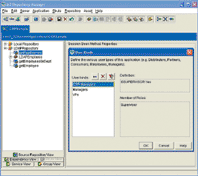M7 Suite Update Offers Better Way To Assemble Applications
M7 4.0 is more application-server-agnostic than BEA Systems' Workshop. In fact, M7 applications don't require an application server to execute. Depending on an application's requirements, developers can deploy M7 with a servlet container, an app server or both.

\
MARIO MOREJON
\
Technical Editor
This is especially useful because there are many instances where a Java Server Page (JSP) container such as Tomcat's Servlet is preferred. For example, applications that only require displaying information by directly accessing databases can maintain all the code in JSPs.
BEA's application server generates BEA Workshop's workflows, thus locking them into the app server. By contrast, M7's user workflows are represented by XML files. Although not as code-centric as BEA's workflows, M7's workflows include a number of logic statements such as if-then-else clauses, loops and switch statements. Workflows can incorporate profile- and role-based logic as well.
Using the M7 platform, developers also can embed snippets of Java code to a large extent. The Java code can be used to bridge any parameter from components and to reformat messages from Web services that are difficult to transform through XSLT files. How the runtime server manipulates the Java code is not clear because the current version does not save Java snippets in a repository or make them accessible as components, Test Center engineers found.
M7 integrates with Borland JBuilder and the open-source Eclipse IDE. By double-clicking on a component in M7's repository or in the workflow editor, programmers will be able to view the source code. M7 applications are component-based and can be developed with Java or connected through Web services, so even .Net Web services can be executed using M7's application workflows.
M7 also helps developers construct service-oriented applications for the Web. The ISV is now promoting a new development paradigm based on the model view controller 2 (MVC 2) design pattern.

\
M7 APPLICATION ASSEMBLY SUITE 4.0
\
CRN Test Center Recommended
The MVC 2 architecture is considered one of the best practices for developing Web applications. In the past, the MVC method of programming has proven itself in three-tier GUI applications. M7's Web architecture breaks MVC 2 into three layers that correspond to three products in the suite. The view layer is considered by M7 as the presentation layer (HTML/JSP pages). The controller layer drives the business logic and the behavior of an application, so it resides as components in an app server. In the model layer, where all corporate assets exist, M7 has a repository that manages all components that connect databases and file servers into applications. Essentially, the three tools in M7's application design that model the MVC architecture are a JSP editor, a workflow editor and the repository.
A visual JSP editor allows developers to drag and drop into pages data being pulled from databases or information being pulled from a Web service. For this to occur, the controller layer, which drives the behavior of the application and indicates the business logic, needs to be executed. That is driven through a workflow component using various icons that describe logic paths.
M7 next assembles applications, executes them using a runtime component, takes the XML files generated from the workflow process and turns them into Java code. The code can run from either a Java application server or a Java servlet container.
M7 workflow icons are easy to read. The Test Center does not foresee developers having to create spaghetti code, since most of the logical structures are built into graphical elements. A gear icon, for instance, represents a Java component or Web service. In addition, the JSPs and workflow code that M7 generate are reusable. In most cases, workflow code can be used in repetitive tasks such as log-on screens or data validation routines.
Version 4.0 supports Jakarta's Struts framework, which promotes coding standards that follow the MVC 2 paradigm. All of the JSP tags that the Struts tags use are manageable in M7's repository. M7's workflow tool also can work with the Struts code using simple page constructs, but the Struts code is limited to actions that specify which pages to present based on simple conditional statements.
M7 is working on adhering to the Web service business process execution language (BPEL), which is designed to execute business processes by specifying logical patterns in a platform-independent description language.
CHANNEL PROGRAM SNAPSHOTS
>M7 APPLICATION ASSEMBLY SUITE 4.0
PRICE: $12,500 per server plus $3,000 per developer
MARGIN: 30 percent
WARRANTY: 90 days
DISTRIBUTORS: Direct from vendor
TECH RATING:

CHANNEL RATING:

CHANNEL OVERVIEW: Cupertino, Calif.-based M7 recently launched its channel program and provides thorough sales and technical assistance. The vendor's sales staff participate in joint sales calls, and its engineers assist in solution design and provide on-site technical assistance. Technical training is offered monthly at the vendor's headquarters. M7's solution provider Web site includes training programs, sales materials, numerous presentations and technical resources, and M7 keeps solution providers updated on sales and technical news via a monthly newsletter.
Note: Vendors can earn up to five stars for technical merit and five for their channel program. If the average of these two scores is four stars or greater, the product earns CRN Test Center Recommended status.